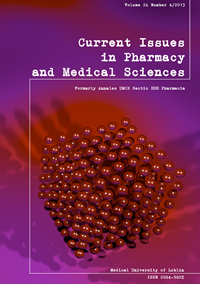Pathophysiological aspects of the pancreas functionin rats with monosodium glutamate-induced obesity
DOI:
https://doi.org/10.12923/j.2084-980X/26.4/a.01Keywords:
monosodium glutamate, pancreas, pancreatitisAbstract
Our study demonstrates that neonatal treatment with monosodium glutamate (MSG) leads to the development of visceral obesity in adult rats. In rats’ pancreas of both sexes massive edema and inflammation were found, which are characteristic of acute pancreatitis. Marked intralobular and perivascular lipomatosis was also found. There was also marked leukocyte infiltration in rats with MSG-induced obesity. Morphometric analysis confirmed pathological changes in pancreatic tissue. The level of blood amylase, lipase and pancreatic amylase was increased by 92% (p<0.001), 312% (p<0.001) and 162% (p<0.001). So, neonatal treatment with MSG leads to the development of pancreatitis in adulthood of rats. We concluded that the development of pancreatitis in rats with MSG-induced obesity is the result of increase of synthetic and secretory processes in pancreatic cells.
References
1. Araki H. et al.: Adiponectin plays a protective role in caerulein-induced acute pancreatitis in mice fed a high-fat diet. Gut, 57, 1431-1440, 2008. https://doi.org/10.1136/gut.2007.135665
2. Brahm A., Hegele R.: Hypertriglyceridemia. Nutrients., 5, 981-1001, 2013. https://doi.org/10.3390/nu5030981
3. Ellis M.P., French J.J., Charnley R.M. Acute pancreatitis and the influence of socioeconomic deprivation. Br. J. Surg., 96, 74-80, 2009. https://doi.org/10.1002/bjs.6414
4. Franco-Pons N., Gea-Sorlí S., Closa D. Release of inflammatory mediators by adipose tissue during acute pancreatitis. J. Pathol., 221, 175-182, 2010. https://doi.org/10.1002/path.2691
5. Freeman M.: Reconsidering the effects of monosodium glutamate: a literature review. J. Am. Acad. Nurse Pract., 18, 10, 482-486, 2006. https://doi.org/10.1111/j.1745-7599.2006.00160.x
6. Frulloni L. et al.: Pancreatic hyperenzymemia: clinical significance and diagnostic approach. JOP. J. Pancreas (Online), 6, 536-51, 2006.
7. Gullo L. Benign pancreatic hyperenzymemia or Gullo’s syndrome. JOP., 7, 241 242, 2007.
8. Khokhar A.S., Seidner D.L.: The pathophysiology of pancreatitis. Nutr. Clin. Pract., 19, 5-15, 2004. https://doi.org/10.1177/011542650401900105
9. Nakagawa T. et al.:Effects of chronic administration of sibutramine on body weight, food intake and motor activity in neonatally monosodium glutamate-treated obese female rats: relationship of antiobesity effect with monoamines. Exp. Anim., 49, 239-249, 2000. https://doi.org/10.1538/expanim.49.239
10. Oida K. et al.: Plasma lipoproteins of monosodium glutamate-induced obese rats. Int. J. Obes., 8, 5, 385-391, 1984.
11. Pandol S.J. et al.: Acute pancreatitis: bench to the bedside. Gastroenterology, 133, 1056, 1–25, 2007.
12. Pereda J. et al.: Obese rats exhibit high levels of fat necrosis and isoprostanes in taurocholate-induced acute pancreatitis. PLoS ONE, 7, 9, 44383, 2012. https://doi.org/10.1371/journal.pone.0044383
13. Sandhu S. et al.: Incidence of pancreatitis, secondary causes, and treatment of patients referred to a specialty lipid clinic with severe hypertriglyceridemia: A retrospective cohort study. Lipids Health Dis., 10, 157, 2011. https://doi.org/10.1186/1476-511x-10-157
14. Segersvärd R. et al.: Obesity alters cytokine gene expression and promotes liver injury in rats with acute pancreatitis. Obesity, 16, 23-28, 2008. https://doi.org/10.1038/oby.2007.27
15. Sempere L. et al.: Obesity and fat distribution imply a greater systemic inflammatory response and a worse prognosis in acute pancreatitis. Pancreatology, 8, 257-264, 2008. https://doi.org/10.1159/000134273
Downloads
Published
Issue
Section
License
Copyright (c) 2013 Authors

This work is licensed under a Creative Commons Attribution-NonCommercial-NoDerivatives 3.0 Unported License.


